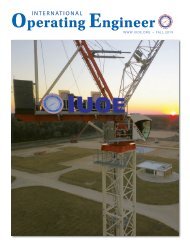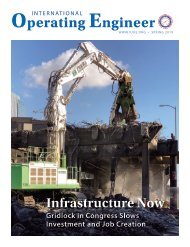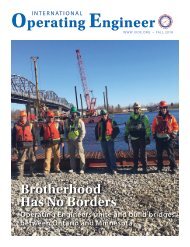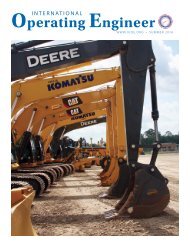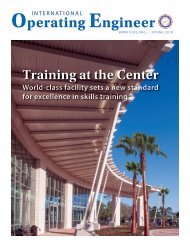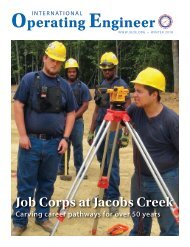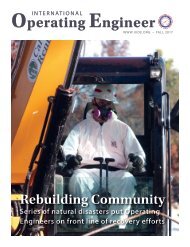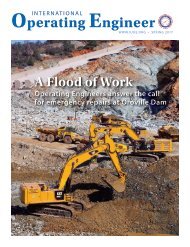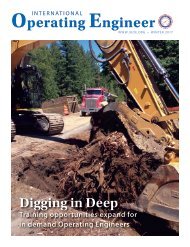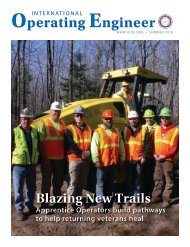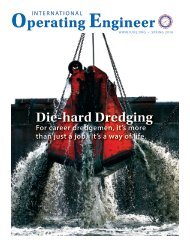Operating Engineer - Fall 2014
The quarterly magazine of the International Union of Operating Engineers.
The quarterly magazine of the International Union of Operating Engineers.
You also want an ePaper? Increase the reach of your titles
YUMPU automatically turns print PDFs into web optimized ePapers that Google loves.
Healthcare<br />
What Are the Health Risks of Overweight and Obesity?<br />
Member Spotlight<br />
Union Investment Pays Off for Workers and Community<br />
BEING OVERWEIGHT OR OBESE isn’t a cosmetic<br />
problem. These conditions greatly raise your risk for other<br />
health problems.<br />
Coronary Heart Disease<br />
As your body mass index (BMI) rises, so does your risk<br />
for coronary heart disease. This is a condition in which a<br />
waxy substance called plaque builds up inside the coronary<br />
arteries. These arteries supply oxygen-rich blood to your<br />
heart.<br />
Plaque can narrow or block the coronary arteries and<br />
reduce blood flow to the heart muscle. This can cause angina<br />
or a heart attack. (Angina is chest pain or discomfort.)<br />
Obesity also can lead to heart failure. This is a serious<br />
condition in which your heart can’t pump enough blood to<br />
meet your body’s needs.<br />
High Blood Pressure<br />
Blood pressure is the force of blood pushing against the<br />
walls of the arteries as the heart pumps blood. If this pressure<br />
rises and stays high over time, it can damage the body in<br />
many ways.<br />
Stroke<br />
Being overweight or obese can lead to a buildup of plaque<br />
in your arteries. Eventually, an area of plaque can rupture,<br />
causing a blood clot to form.<br />
If the clot is close to your brain, it can block the flow of<br />
blood and oxygen to your brain and cause a stroke. The risk<br />
of having a stroke rises as BMI increases.<br />
Type 2 Diabetes<br />
Diabetes is a disease in which the body’s blood glucose,<br />
or blood sugar, level is too high. Normally, the body breaks<br />
down food into glucose and then carries it to cells throughout<br />
the body. The cells use a hormone called insulin to turn the<br />
glucose into energy.<br />
In type 2 diabetes, the body’s cells don’t use insulin<br />
properly. At first, the body reacts by making more insulin.<br />
Over time, however, the body can’t make enough insulin to<br />
control its blood sugar level.<br />
Diabetes is a leading cause of early death, heart disease,<br />
stroke, kidney disease, and blindness. Most people who have<br />
type 2 diabetes are overweight.<br />
Abnormal Blood Fats<br />
If you’re overweight or obese, you’re at increased risk<br />
of having abnormal levels of blood fats. These include high<br />
levels of triglycerides and LDL (“bad”) cholesterol and low<br />
levels of HDL (“good”) cholesterol.<br />
Abnormal levels of these blood fats are a risk factor for<br />
coronary heart disease.<br />
Metabolic Syndrome<br />
Metabolic syndrome is the name for a group of risk<br />
factors that raises your risk for heart disease and other health<br />
problems, such as diabetes and stroke.<br />
You can develop any one of these risk factors by itself,<br />
but they tend to occur together. A diagnosis of metabolic<br />
syndrome is made if you have at least three of the following<br />
risk factors:<br />
• A large waistline. This is called abdominal obesity or<br />
“having an apple shape.” Having extra fat in the waist<br />
area is a greater risk factor for CHD than having extra<br />
fat in other parts of the body, such as on the hips.<br />
• A higher than normal triglyceride level (or you’re on<br />
medicine to treat high triglycerides).<br />
• A lower than normal HDL cholesterol level (or you’re<br />
on medicine to treat low HDL cholesterol).<br />
• Higher than normal blood pressure (or you’re on<br />
medicine to treat high blood pressure).<br />
• Higher than normal fasting blood sugar (or you’re on<br />
medicine to treat diabetes).<br />
Cancer<br />
Being overweight or obese raises your risk for colon,<br />
breast, endometrial, and gallbladder cancers.<br />
Osteoarthritis<br />
Osteoarthritis is a common joint problem of the knees,<br />
hips, and lower back. The condition occurs if the tissue that<br />
protects the joints wears away. Extra weight can put more<br />
pressure and wear on joints, causing pain.<br />
Sleep Apnea<br />
Sleep apnea is a common disorder in which you have one<br />
or more pauses in breathing or shallow breaths while you<br />
sleep.<br />
A person who has sleep apnea may have more fat stored<br />
around the neck. This can narrow the airway, making it hard<br />
to breathe.<br />
KEVIN HAGANS, a married<br />
father of two, is a member of Local<br />
14-14B. He is currently working<br />
on the Riverside Drive project in<br />
New York City, a 100% union-built<br />
property located along the Hudson<br />
River in the Upper West Side of<br />
Manhattan. The project is being<br />
financed by the AFL-CIO Building<br />
Investment Trust. Kevin expects to<br />
be on the site until the foundation of<br />
the building is complete.<br />
Kevin, who has been an IUOE<br />
member for the past 31 years, is<br />
currently the Master Mechanic on<br />
the development project. When<br />
asked what this work means to<br />
him, Kevin explains, “Providing a<br />
very good livelihood for my family<br />
and, of course, having steady<br />
employment. It is also important for<br />
the project to be done<br />
with experienced and<br />
skilled union labor.”<br />
The AFL-CIO<br />
Building Investment<br />
Trust (BIT) is an<br />
equity partner in<br />
the construction<br />
of the $420 million<br />
development project<br />
that Kevin is helping to<br />
build. It will stand over<br />
40 stories tall, totaling<br />
nearly 750,000 square<br />
feet. It will include<br />
approximately 590<br />
apartments, with 80%<br />
of the units priced at<br />
market rate and 20%<br />
as affordable units.<br />
The building will also<br />
include retail space,<br />
unique access to green space, and a New York City public<br />
school that will be constructed on the first five floors.<br />
In addition to Riverside, the AFL-CIO Building<br />
Investment Trust has eight other projects currently in<br />
development across the country. Total development cost<br />
for these projects is approximately $1 billion, and they are<br />
expected to create some 5,000 union jobs throughout the<br />
course of construction. That means roughly 10 million union<br />
construction hours are currently underway, and more jobs<br />
will be created once these projects are complete.<br />
Over the past 26-year history of the program, since<br />
beginning operations in 1988, the BIT has invested $5.5<br />
billion for the development and acquisition of more than 180<br />
office, retail, multifamily, hotel, warehouse, and mixed-use<br />
properties across the country. As of June 30, <strong>2014</strong>, the BIT<br />
had a net asset value of $3.15 billion and a portfolio of 53<br />
properties across the United States.<br />
The AFL-CIO Building Investment Trust is a bank<br />
collective trust servicing qualified union pension plans, for<br />
which PNC Bank serves as the trustee. One mission of the BIT<br />
is to provide investors with competitive risk-adjusted returns<br />
through investments in institutional-quality commercial real<br />
estate that seek to generate competitive levels of income and<br />
long-term capital appreciation. The BIT acquires, constructs,<br />
and owns a diverse portfolio that spans the country. It also<br />
provides collateral benefits such as union job creation<br />
and economic development by utilizing one of the most<br />
comprehensive union labor policies in the U.S. real estate<br />
industry.<br />
[above] IUOE Local 14 member Kevin Hagans is the Master<br />
Mechanic on the AFL-CIO Building Investment Trust’s 56-acre<br />
Riverside Center development project in New York City.<br />
22<br />
INTERNATIONAL OPERATING ENGINEER<br />
FALL <strong>2014</strong> 23




